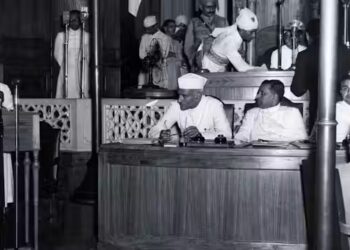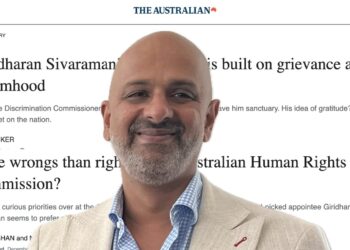Some Hindus may describe their personal encounters with prejudice as ‘Hinduphobia.’ But the term has long been weaponized by Hindutva nationalists to deflect their own phobias against Muslims and Christians.
Raju Rajgopal
“File:RSS at Penchalakona.JPG” by YVSREDDY is licensed under CC BY-SA 3.0
My extended family and I have called America home for over five decades. We have built successful businesses and raised children who went to racially diverse schools as well as to predominantly white schools. Our journey as a minority has made us sensitive not only to the debt that we owe to the civil rights struggle but has also made us more aware of our silent acquiescence to casteism in India, which is now rearing its ugly head in the American workplace.
As beneficiaries of America’s liberalized immigration policies of the late 1960s, we were welcomed with open arms by this amazing country of hopes and opportunities. But on occasion we have also encountered prejudices and ignorance, not atypical for new immigrants.
As a student, I was physically thrown out of an apartment building by the manager shouting angry racial epithets. My daughter was teased at school, especially after the movie “Gandhi” was released. We have been deliberately ignored by waiters in restaurants. As supporters of the first major Hindu temple in the San Francisco Bay Area, we heard many objections by neighbors. And, in the Trump era, some of us have met with an occasional “Go back home” cry or a contemptuous stare.
But in all these encounters, we never once felt that we were being targeted because of our Hindu faith.
In most cases, our brown skins and loud foreign tongues may have been enough to trigger hostility. Our usual response to such xenophobia has been to brush off our momentary anger and, when possible, to educate friends and colleagues about India and Hinduism. As immigrants anxious to start new lives in America, my generation simply couldn’t afford to be thin-skinned.
Making Sense of ‘Hinduphobia’
Fast forward, in the last few years we have seen a meteoric rise of Indian/Hindu Americans in every segment of our society, including in the government, the corporate world, the entertainment industry, and in mainstream media. School curricula are becoming much more sensitive to coverage of India and Hinduism. And I dare say that we are seeing an unprecedented level of positive coverage of the community these days.
What then warrants sudden cries of ‘Hinduphobia’ from some in the Hindu American community?
I hear two competing narratives, coming from two very different motivations:
On one side, I hear concerned voices of the younger generation, who may be encountering many more instances of prejudice and feelings of exclusion than my generation did. As other students get more exposed to India and Hinduism, teasing and bullying may be on the rise in schools and colleges. Also, in many inter-faith spaces, Hindus are still treated as outsiders or at best as junior partners. And since the pandemic, Indian Americans are also encountering more instances of hate, although Asian Americans seem to be the primary targets.
But, unlike my 1960s generation, today’s youngsters are not willing to simply brush off encounters of prejudice. They fully expect and demand to be treated as equals in this country. My colleague at Hindus for Human Rights (HfHR), Sravya, has recently described her own experiences growing up Hindu in an all-white neighborhood. She makes me wonder if perhaps my generation is guilty of presuming that the NextGen will also navigate American society with the same thick-skinned nonchalance as we did.
On the other, darker side, I hear strident voices of Hindutva nationalists, ever ready to claim victimhood, even as they take full advantage of their welcome in this multicultural society. ‘Hinduphobia’ is only the latest concept in their lexicon, weaponized both here and in India to delegitimize critics. Over the years, I have myself been called pseudo-secular, Hindu baiter, Muslim lover, closet evangelist, communist, and so on.
If today’s leaders are declaring open season on India’s minorities, we must understand that most of them have been steeped in RSS indoctrination over the decades.
Such name-calling is of course meant to distract from the reality that their own raison d’etre is the deeply held intolerance and aversion towards Islam and Christianity — and, more recently, the unprecedented scale of assault that Hindutva rule in India has unleashed upon the minorities. I am quite sure that they will now also conveniently label as “Hinduphobia” and “anti-India” the mounting international criticism of the mishandling of the pandemic by the Modi government.
The Darker Side of the Narrative
It’s important that our younger generations, especially Hindu students born in this country, understand the roots of the darker side of the ‘Hinduphobia’ narrative, before they rush to label their own encounters with prejudice as a phobia. While their narratives are all about inclusion and wanting to be treated as equals in this society, the narrative of Hindutva nationalists flows from their foundational ideology of excluding Muslims and Christians from the Indian mainstream. Naturally, they are intent on co-opting alienated Hindu students into their divisive agenda.
To understand what real phobias look like, students must take the time to examine the century-old history of anti-minority campaigns by the Rashtriya Swayamsewak Sangh (RSS). To quote Master Yoda, “In a dark place we find ourselves, and a little more knowledge lights our way.” (See References Stops #1 to #13):
They can start with V.D. Savarkar of the Hindu Mahasabha, precursor to the RSS, who coined the word ‘Hindutva,’ and held forth that Muslims in independent India “will have the position of negroes in your country.” (#1) K.B. Hedgewar, the founder of the RSS, who frequently invoked stereotypes and fear of Muslims, and bemoaned the “apathy of the Hindu society” and sought to “rouse the dormant manliness of the Hindus.” (#2) M.S. Golwalkar, the longest head of the RSS, who wrote that Nazi Germany’s treatment of the Jews was “national pride at its highest…a good lesson…to profit by.” (#3) Golwalkar’s pronouncements as the chief of RSS reached new levels of Islamophobia, as he explicitly laid the foundation for a majoritarian “Hindu Rashtra,” where minorities could live only under the “goodwill” of the majority (i.e., as second-class citizens.) (#4) ‘Guruji,’ as he is known in Hindutva circles, is especially venerated by Hindutva nationalists, both in India and in the U.S. (#5)
Post Golwalkar, the writings of General Secretary of the RSS, H.V. Sheshadri, are particularly important. Besides endorsing the anti-minority ideology and conspiracy theories of the RSS founders, he also takes ownership of the linkages between the RSS and other Hindutva influenced organizations worldwide as “one of mother and her children…bound by fraternal ties.” (#6)
They can also study writers who have had a great deal of influence on Hindutva thinking, such as: Harsh Narain, who believed that Hindu culture alone deserves the credit of recognition as the national culture of India…and that Muslim and Christian cultures are “parasitic cultures.” (#7) And Sitaram Goel, who declared that “Hindu temples are not safe as long as [Hindus] recognize Islam as a religion” and likened Jesus to a “piece of junk.” (#8)
They might also look up Western scholars who not only embrace Hindutva but accuse secular and progressive Hindus of being subservient to the West. As Westerners putting down Western scholarship, they have earned a special place among Hindutva intellectuals. Some of the names that come to my mind are Koenraad Elst, Michael Danino and David Frawley. (#9-11)
Golwalkar’s Dream
If today’s leaders are declaring open season on India’s minorities, we must understand that most of them have been steeped in RSS indoctrination over the decades. Many of the authors above have been their role models and heroes.
If the then Chief Minister Modi of Gujarat refused to visit a single Muslim victim of the 2002 pogroms and referred to relief camps as “open child producing centers”; if Subramanya Swamy called for stripping Muslims of their voting rights unless they acknowledge their Hindu ancestry; if Home Minister Amit Shah called undocumented Muslims as “termites,” while offering citizenship to undocumented Hindus; if the RSS chief declared that a Hindu Rashtra is non-negotiable; and if Yati Narasinghanand Saraswati, a priest at a Hindu temple, called for eliminating all Muslims…they are all essentially speaking from the same playbook and are striving to make the dream of Golwalkar come true. (#13)
Unfortunately, hubris and arrogance of the rulers that come with unbridled political power, are moving India closer to the edge of the abyss. Now, with the gross mismanagement of the pandemic by a government eager to please the Hindu majority, the situation in the country is being described by some as the pralaya (apocalypse).
“Arise! Awake! And Stop Not Till the Goal is Reached!” exhorted Swamy Vivekananda in late 19th century, addressing Indians thirsting to throw off the shackles of British colonial rule.
Today, I must direct that very cry to my fellow Hindu Americans who have largely remained silent as Hindutva nationalists in India indulge in vile inhuman acts and then presume to speak for all of us. Let us not follow the Pied Pipers over the abyss.
This article was first published in American Kahani
The views and opinions expressed in this article are those of the authors and do not necessarily reflect the editorial views or position of NRI Affairs.
Raju Rajagopal is a co-founder of Hindus for Human Rights, an advocacy organization dedicated to human rights of all communities in India and the U.S. Details at www.hindusforhumanright.org. The above views are personal.
Follow NRI Affairs on Facebook, Twitter and Youtube.











